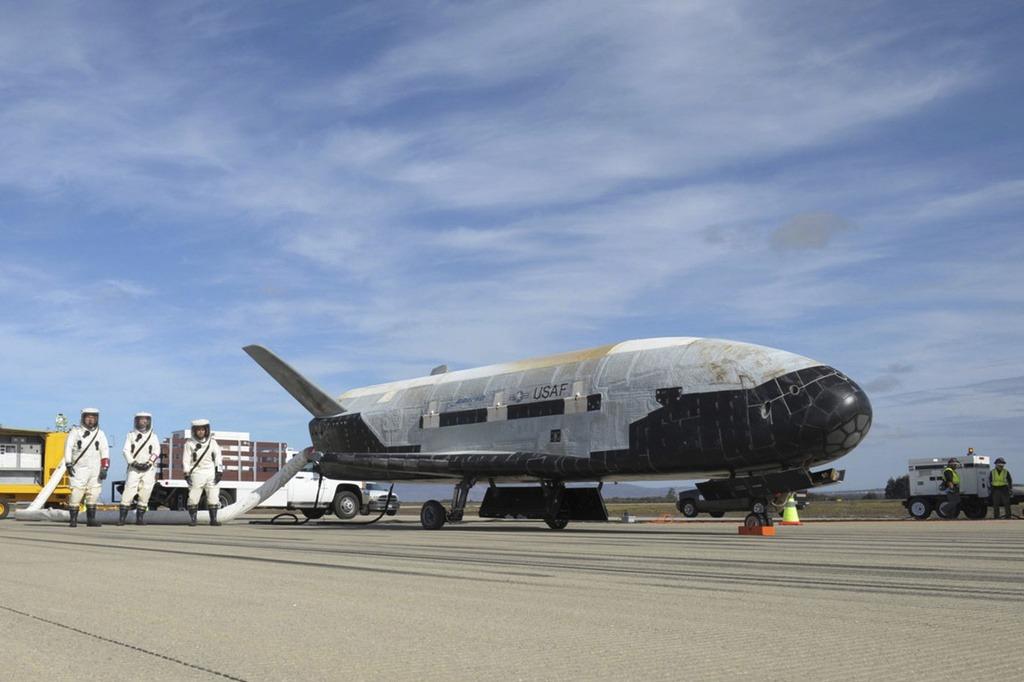 The US military's secretive X-37B robot spaceplane lifts off on its seventh mission to orbit, the vehicle's first launch atop a SpaceX Falcon Heavy rocket capable of lofting it far higher than ever before from the Kennedy Space Center in Cape Canaveral, Florida, the United States, Dec 28, 2023. (PHOTO / REUTERS)
The US military's secretive X-37B robot spaceplane lifts off on its seventh mission to orbit, the vehicle's first launch atop a SpaceX Falcon Heavy rocket capable of lofting it far higher than ever before from the Kennedy Space Center in Cape Canaveral, Florida, the United States, Dec 28, 2023. (PHOTO / REUTERS)
CAPE CANAVERAL, Florida - The US military's secretive X-37B robot spaceplane blasted off from Florida on Thursday night on its seventh mission, the first launched atop a SpaceX Falcon Heavy rocket capable of delivering it to a higher orbit than ever before.
The Falcon Heavy, composed of three liquid-fueled rocket cores strapped together, roared off its launch pad from NASA's Kennedy Space Center at Cape Canaveral in a spectacular liftoff carried live on a SpaceX webcast.
The launch followed more than two weeks of false starts and delays attributed to poor weather and unspecified technical issues, leading ground crews to roll the spacecraft back to its hangar before proceeding with Thursday's flight.
The Pentagon has disclosed few details about the X-37B mission, conducted by the US Space Force under the military's National Security Space Launch program.
The Pentagon has disclosed few details about the X-37B mission, conducted by the US Space Force under the military's National Security Space Launch program
The Boeing-built vehicle, roughly the size of a small bus and resembling a miniature space shuttle, is built to deploy various payloads and conduct technology experiments on years-long orbital flights. At the end of its mission, the craft descends back through the atmosphere to land on a runway much like an airplane.
It has flown six previous missions since 2010, the first five of them carried to orbit by Atlas V rockets from United Launch Alliance, a joint venture of Boeing and Lockheed Martin, and most recently, in May 2020, atop a Falcon 9 booster furnished by Elon Musk's SpaceX.
ALSO READ: SpaceX delays planned launch of US military's X-37B spaceplane
Thursday's mission marked the first launched aboard SpaceX's more powerful Falcon Heavy rocket, capable of carrying payloads even heavier than the X-37B farther into space, possibly into geosynchronous orbit, more than 35,000 km above the Earth.
The X-37B, also called the Orbital Test Vehicle, has previously been confined to flights in low-Earth orbit, at altitudes below 2,000 km.
 This undated photo provided by the US Air Force shows an X-37B Orbital Test Vehicle at NASA's Kennedy Space Center in Florida. (PHOTO / AP)
This undated photo provided by the US Air Force shows an X-37B Orbital Test Vehicle at NASA's Kennedy Space Center in Florida. (PHOTO / AP)
'New orbital regimes, and seeds'
The Pentagon has not said how high the spaceplane will fly this time out. But in a statement last month, the Air Force Rapid Capabilities Office said the mission, designated by the Space Force as USSF-52, would involve tests of "new orbital regimes, experimenting with future space domain awareness technologies".
Such comments have led industry analysts and amateur space trackers to speculate that the X-37B may be bound for a highly elliptical orbit around Earth or even a path that could swing it out to the vicinity of the moon, a region of space in which the Pentagon has taken an increasing interest.
ALSO READ: SpaceX Dragon cargo spacecraft back to Earth with samples
The planned duration of the latest X-37B mission was not made public, but it will presumably run until June 2026 or later, given the prevailing pattern of successively longer flights
"Maybe this thing's going go out toward the moon and drop off a payload," said Bob Hall, director of space traffic monitoring firm COMSPOC, who analyzes the trajectories of orbital objects. The closer the spacecraft flies to the moon, the more difficult it could be to safely return to Earth.
Left unclear from Thursday's webcast, which SpaceX said it curtailed at the military's request, was whether the X-37B reached its intended destination in space. But the company later posted photos of the liftoff on social media platform X with the headline: "Falcon Heavy Launches USSF-52 to orbit."
The X-37B also is carrying a NASA experiment to study how plant seeds are affected by prolonged exposure to the harsh environment of radiation in space. The ability to cultivate crops in space has major implications for keeping astronauts nourished during future long-term missions to the moon and Mars.
The planned duration of the latest X-37B mission was not made public, but it will presumably run until June 2026 or later, given the prevailing pattern of successively longer flights.
READ MORE: NASA's Artemis mission heads to moon on debut test flight
Its last mission remained in orbit for well over two years before landing in November 2022.


